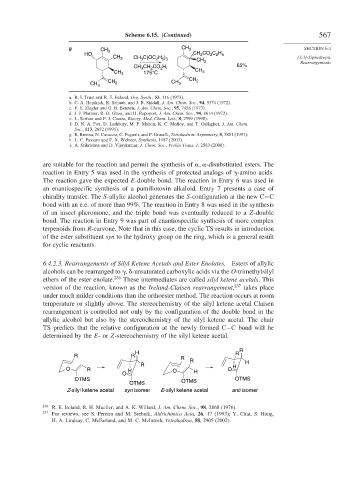Page 593 - Advanced Organic Chemistry Part B - Reactions & Synthesis
P. 593
Scheme 6.15. (Continued) 567
9 i CH 3 CH 3 SECTION 6.4
HO CH 2 CO 2 C 2 H 5
CH 3 CH 3 C(OC 2 H 5 ) 3 [3,3]-Sigmatropic
CH 3 Rearrangements
CH 3 CH 2 CO 2 H, 65%
CH 3 175°C CH 3
CH 2
CH 2 CH 3
CH 3
a. R. I. Trust and R. E. Ireland, Org. Synth., 53, 116 (1973).
b. C. A. Hendrick, R. Schaub, and J. B. Siddall, J. Am. Chem. Soc., 94, 5374 (1972).
c. F. E. Ziegler and G. B. Bennett, J. Am. Chem. Soc., 95, 7458 (1973).
d. J. J. Plattner, R. D. Glass, and H. Rapoport, J. Am. Chem. Soc., 94, 8614 (1972).
e. L. Serfass and P. J. Casara, Bioorg. Med. Chem. Lett., 8, 2599 (1998).
f. D. N. A. Fox, D. Lathbury, M. F. Mahon, K. C. Molloy, and T. Gallagher, J. Am. Chem.
Soc., 113, 2652 (1991).
g. E. Brenna, N. Caraccia, C. Fuganti, and P. Graselli, Tetrahedron: Asymmetry, 8, 3801 (1997).
h. L. C. Passaro and F. X. Webster, Synthesis, 1187 (2003).
i. A. Srikrishna and D. Vijaykumar, J. Chem. Soc., Perkin Trans. 1, 2583 (2000).
are suitable for the reaction and permit the synthesis of -disubstituted esters. The
reaction in Entry 5 was used in the synthesis of protected analogs of -amino acids.
The reaction gave the expected E-double bond. The reaction in Entry 6 was used in
an enantiospecific synthesis of a pumiliotoxin alkaloid. Entry 7 presents a case of
chirality transfer. The S-allylic alcohol generates the S-configuration at the new C−C
bond with an e.e. of more than 99%. The reaction in Entry 8 was used in the synthesis
of an insect pheromone, and the triple bond was eventually reduced to a Z-double
bond. The reaction in Entry 9 was part of enantiospecific synthesis of more complex
terpenoids from R-carvone. Note that in this case, the cyclic TS results in introduction
of the ester substituent syn to the hydroxy group on the ring, which is a general result
for cyclic reactants.
6.4.2.3. Rearrangements of Silyl Ketene Acetals and Ester Enolates. Esters of allylic
alcohols can be rearranged to
-unsaturated carboxylic acids via the O-trimethylsilyl
ethers of the ester enolate. 236 These intermediates are called silyl ketene acetals. This
version of the reaction, known as the Ireland-Claisen rearrangement, 237 takes place
under much milder conditions than the orthoester method. The reaction occurs at room
temperature or slightly above. The stereochemistry of the silyl ketene acetal Claisen
rearrangement is controlled not only by the configuration of the double bond in the
allylic alcohol but also by the stereochemistry of the silyl ketene acetal. The chair
TS predicts that the relative configuration at the newly formed C−C bond will be
determined by the E-or Z-stereochemistry of the silyl ketene acetal.
R
H R
R R
R R
R H H
O R H O O
O H
OTMS OTMS OTMS
OTMS
Z-silyl ketene acetal syn isomer E-silyl ketene acetal anti isomer
236 R. E. Ireland, R. H. Mueller, and A. K. Willard, J. Am. Chem. Soc., 98, 2868 (1976).
237
For reviews, see S. Pereira and M. Srebnik, Aldrichimica Acta, 26, 17 (1993); Y. Chai, S. Hong,
H. A. Lindsay, C. McFarland, and M. C. McIntosh, Tetrahedron, 58, 2905 (2002).

